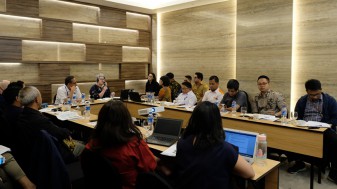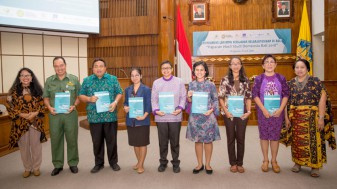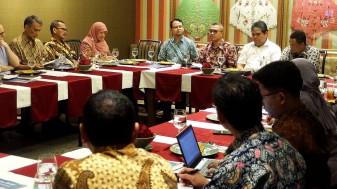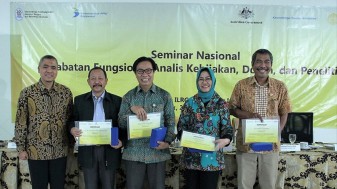The Indonesian government issued Government Regulation no. 17 of 2017 concerning Synchronization of the National Development Planning and Budgeting Process. This regulation mandates the Minister for National Development Planning and the Minister of Finance to share quality data and synchronize the national development planning and budgeting process in an effective and efficient manner. The Planning and Budget Performance Information Collaborative (KRISNA) application managed by the Ministry of National Development Planning/Bappenas and supported by the Knowledge Sector Initiative (KSI) is a form of implementing the development mandate.
After two years of reorganization and development, in 2019 the Main Inspectorate of Bappenas conducted a study on the governance of the KRISNA application. This activity aimed to produce policy recommendations to the Ministry of National Development Planning/Bappenas on the strategic role of KRISNA for bureaucratic reform, especially in relation to strengthening the synchronization of national development planning and budgeting, including strategies for strengthening the use of KRISNA data through the KRISNA dashboard application.
In the study, the Main Inspectorate received expert support from the Center for Study of Governance and Administrative Reforms (UI-CSGAR) – University of Indonesia and the Knowledge Sector Initiative (KSI). The assessment method is a desk study using secondary data in the form of documentation of activities produced by IU’s e-Gov Lab. Analysis was also carried out based on regulatory review related to KRISNA implementation. The study shows that KRISNA is used by all ministries/agencies in managing performance accountability information, especially in the planning and budgeting stages of development programs. This application ensures that ministry/agency budget allocations prioritize national priority programs.
During the review, three items were identified that could be further developed in the KRISNA system, namely policies and procedures related to the development of information and communication technology, management organization, and information security. These three items seem to have a significant effect on the role of KRISNA in supporting performance-based learning and control, especially to ensure ministry/agency commitment in planning and budgeting for priority programs.
KRISNA’s Data Analysis Dashboard has three main modules, namely the Tagging Dashboard, Anomaly Dashboard, and the Leadership Dashboard. The Tagging dashboard visualizes budget ceilings and programs across ministries/agencies. The Anomaly Dashboard displays any strategic goals, program objectives, and activity targets that have not been completed in the ministry/agency work plan. The Leadership Dashboard displays programs, activities and outputs that have been tagged in the ministry/agency work plans in relation to national priorities-priority program-priority activities (PN-PP-KP), priority fields, and Nawacita, the nine visions of the present administration.
Judging from these three modules, the KRISNA dashboard provides significant support for the use of KRISNA data. This dashboard can still be improved, however, especially in terms of integrating KRISNA data managed by Bappenas with other platforms. The data flows in one direction only, from KRISNA to other agency platforms. When data has been processed and updated elsewhere, the results do not return to KRISNA and there is no updating of data at the original source.
Based on these findings, KRISNA can be further strengthened if the KRISNA dashboard is optimally utilized by Bappenas. The strategy involves two main dimensions, namely strengthening the KRISNA system and interoperability and developing the KRISNA dashboard itself. Both dimensions of this strategy are important to ensure KRISNA can address the challenges it faces.
The recommendation is to strengthen KRISNA by further developing its interoperability with related applications, especially e-Monev PP 39/2006, SPAN, SAKTI, and SMART. The ultimate goal is to ensure that the data stored in all these systems is the same.
KRISNA also requires the addition of tag types that can map the roles of programs carried out for internal agencies. Other additions include tracking of changes in ministry/agency work plan documents and a history to see the progress of the document. This feature can also be useful as a tool for continuous learning.
Improvements to the KRISNA dashboard need to be made in all three types. The Tagging Dashboard needs to give access to ministry/agency users to enable viewing of list of output-sub-output-components that have been tagged. The tagging mechanism needs to be improved to enable ministries/agencies, Bappenas directorates as partners, and Bappenas directorates as the sector development coordinator to monitor and evaluate the output components. Ministry/agency access also needs to be expanded to make KRISNA and the KRISNA dashboard part of a decision support system for each agency.
The Anomaly Dashboard needs to be developed so that partner directorates can see not only anomalies at the activity target level, but also at program goal level and ministry/agency strategic objectives. This is important because partner directorates are a critical and strategic partner for every ministry/agency. Partner directorates are also a contact point between Bappenas and ministries/agencies.
The Leadership Dashboard can be enhanced with added visualizations, such as of the types of funding (APBN, APBD, PPP, grants, and other funding) to support KRISNA’s role in ensuring data integration and synergy related to the funding framework. Historical data visualization and budget projections are also needed to support the role of KRISNA in controlling and learning.
Bappenas should implement these recommendations to enhance KRISNA’s role in bureaucratic reform and good governance. That way, KRISNA can further facilitate planning and budgeting for national development to produce targeted and efficient policy programs.






